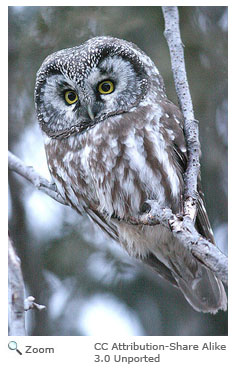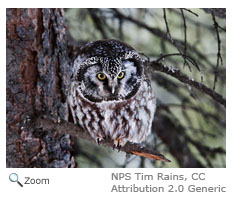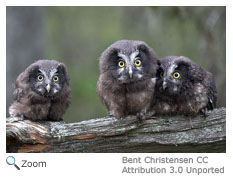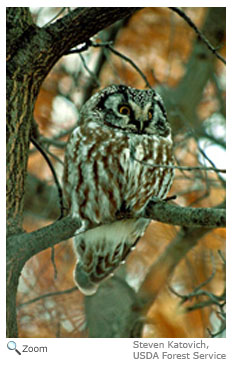Description
 A small owl with no ear tufts, the Boreal Owl has a small white face outlined in black. Many people think the owl looks like it has a white "X" on its face. It has a white body streaked with brown feathers, little white dots on its head and a yellow bill. Females are larger than males. A small owl with no ear tufts, the Boreal Owl has a small white face outlined in black. Many people think the owl looks like it has a white "X" on its face. It has a white body streaked with brown feathers, little white dots on its head and a yellow bill. Females are larger than males.
Range
The Boreal Owl has a very large range. It is widely distributed from Alaska to eastern Canada in subalpine and boreal forests. In the lower 48, the Boreal Owl can also be found in the Cascade and Rocky mountains and in the very northern part of Minnesota. It sometimes visits northern states, like New Hampshire, in the winter time.
Habitat
 Preferring trees in the northern forest belt, the Boreal Owl is found primarily in dense coniferous forests with spruce and balsam fir. It can also be found in forests of deciduous trees with aspen, poplar and birch trees. In North America, the Boreal Owl is found at elevations from 5200 to 10500 feet. Preferring trees in the northern forest belt, the Boreal Owl is found primarily in dense coniferous forests with spruce and balsam fir. It can also be found in forests of deciduous trees with aspen, poplar and birch trees. In North America, the Boreal Owl is found at elevations from 5200 to 10500 feet. |
|
Diet
 The Boreal Owl is carnivorous and feeds on small mammals like voles, mice, chipmunks and squirrels. It also eats insects and small birds, such as the American Robin. Hunting from a protected perch, the Boreal Owl swoops down and grabs its prey with its long talons. During winter and breeding season, the Boreal Owl caches, or saves, its food in its nest or a crook of a tree. The Boreal Owl is carnivorous and feeds on small mammals like voles, mice, chipmunks and squirrels. It also eats insects and small birds, such as the American Robin. Hunting from a protected perch, the Boreal Owl swoops down and grabs its prey with its long talons. During winter and breeding season, the Boreal Owl caches, or saves, its food in its nest or a crook of a tree.
Life Cycle
 Breeding season is from March to June. Depending on the amount of food available, the Boreal Owl will lay different amounts of eggs. Usually, the female lays four or five eggs. She incubates the eggs for 28 days. During this time, the male hunts and brings food to the female, but otherwise stays away from the nest. Once the eggs hatch, the male brings food for the female and the chicks. Chicks fledge, or fly, about thirty days after hatching. Breeding season is from March to June. Depending on the amount of food available, the Boreal Owl will lay different amounts of eggs. Usually, the female lays four or five eggs. She incubates the eggs for 28 days. During this time, the male hunts and brings food to the female, but otherwise stays away from the nest. Once the eggs hatch, the male brings food for the female and the chicks. Chicks fledge, or fly, about thirty days after hatching.
Behavior
 The primary predators of the Boreal Owl are other owls and hawks, like the Great Horned Owl and the Cooper's Hawk. When a Boreal Owl senses a predator, it will try to become very small and motionless, in hopes that the predator won't see them. The Boreal Owl is nocturnal, and hunts at night. The primary predators of the Boreal Owl are other owls and hawks, like the Great Horned Owl and the Cooper's Hawk. When a Boreal Owl senses a predator, it will try to become very small and motionless, in hopes that the predator won't see them. The Boreal Owl is nocturnal, and hunts at night. |





